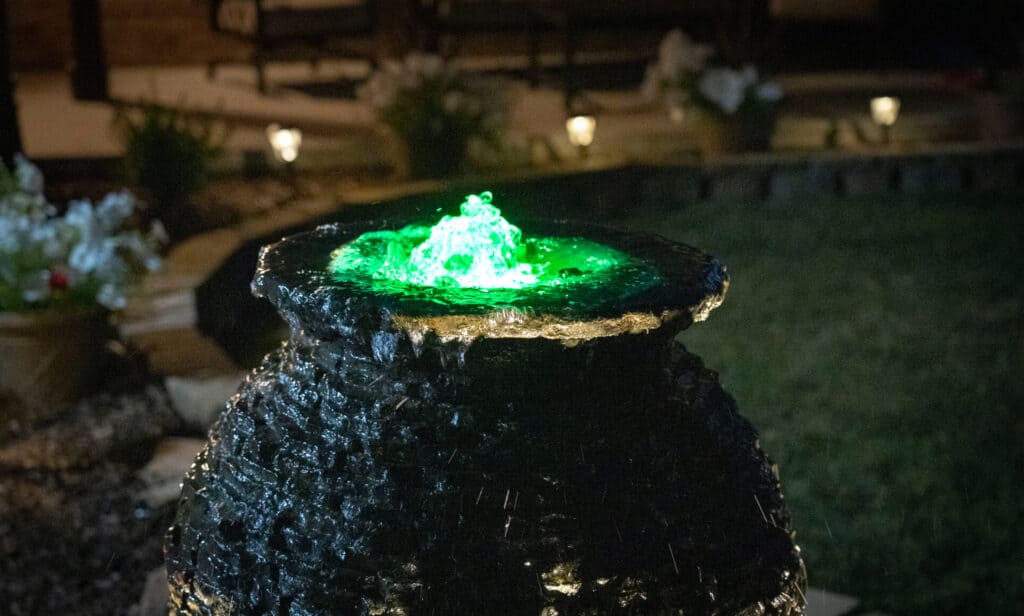As the winter months approach, it is essential to properly winterize your backyard water fountain to ensure it remains in top condition for the next season. This guide will provide you with step-by-step instructions on how to protect your water feature from freezing temperatures, prevent damage, and preserve its beauty for years to come. From draining and cleaning to covering and storing, we’ll cover everything you need to know to winterize your backyard water fountain effectively.

The Importance of winterizing your backyard water fountain
Properly winterizing your backyard water fountain is crucial to avoid costly repairs and potential damage caused by freezing temperatures. By taking the necessary steps to protect your water feature, you can extend its lifespan and preserve its beauty for years to come.
If you don’t winterize your backyard fountain, several things could happen:
- Freezing and Thawing: The most significant risk is the freezing and thawing cycle. Water expands when it freezes, and this can cause damage to the fountain structure, including cracks and breaks in the material.
- Pump Damage: If water freezes inside the pump, it can cause the pump to crack, leading to costly repairs or replacement.
- Water Quality: Leaving water in the fountain over winter can lead to algae growth and poor water quality, which can be difficult to clean in the spring.
- Aesthetic Damage: Winter weather can cause aesthetic damage to your fountain. This includes discoloration, peeling paint, and other surface damage.
- Wildlife Attraction: A non-functioning fountain can attract unwanted wildlife or pests looking for a water source.
Steps to winterize your backyard water fountain properly
To effectively winterize your backyard water fountain, start by draining the water from the fountain and removing any debris or algae buildup. Disconnect and clean the pump, store it in a dry place, and cover the fountain to protect it from harsh weather conditions. Insulate exposed pipes with pipe sleeves and consider using a fountain cover to shield the structure from snow and ice. Additionally, it’s essential to regularly check for any signs of damage throughout the winter season and address them promptly. These steps will help ensure your water fountain remains in excellent condition and ready to shine when spring arrives.
1. Draining the water
Draining the water from your backyard water fountain is a crucial step in winterizing to prevent freezing and damage. Begin by turning off the fountain and unplugging the pump. Using a pump or siphon, empty the water completely from the fountain and all connected pipes. Ensure there is no residual water left to freeze and cause cracks. It’s advisable to clean the fountain basin thoroughly to remove any dirt or debris that may have accumulated. This process will protect your fountain from potential winter weather-related issues, ensuring its longevity and pristine condition for the coming seasons.
2. Disconnecting and cleaning the pump
Once you’ve drained the water, it’s essential to disconnect the pump from the fountain. Thoroughly clean the pump and remove any debris or build-up that could potentially cause issues during the winter months. Inspect the pump for any signs of wear and tear, and consider storing it in a dry and sheltered place to prevent damage. Cleaning the pump ensures it remains in top condition when you reinstall it in the spring.
3. Covering and protecting the fountain
After preparing the pump, the next step is to protect the fountain structure. To protect your backyard fountain in winter, you should use a fountain cover or blanket that is designed for outdoor use and can withstand harsh weather conditions.
Here are some features to consider:
- Secure Fastenings: The cover should have secure fastenings, like drawstrings, elastic hems, or straps, to ensure it stays in place during windy conditions.
- Waterproof: The cover should be waterproof to prevent rain, snow, and ice from reaching the fountain.
- Insulated: An insulated cover will provide additional protection against freezing temperatures.
- UV Resistant: UV resistance will help the cover last longer and protect the fountain from sun damage.
- Size and Fit: The cover should fit your fountain well. It should be large enough to cover the entire fountain, but not so large that it can’t be secured properly.
- Durable Material: Look for covers made from durable materials like polyester or vinyl. These materials are resistant to tearing and can withstand harsh weather conditions.
When it comes to winterizing your backyard water fountain, choosing the right materials and tools is crucial to ensure effective protection. Investing in the proper materials and tools will not only prolong the lifespan of your fountain but also save you time and effort in the long run.
Checking for any potential issues before winter sets in
Before winter arrives, it’s essential to thoroughly inspect your backyard water fountain for any existing problems that could worsen during the colder months. Look for cracks, leaks, or any signs of wear and tear that may need immediate attention. Addressing these issues now will prevent them from escalating and causing further damage once temperatures drop. By conducting a thorough inspection and taking proactive measures to resolve any issues, you’ll ensure that your water fountain is in optimal condition for winter.

Consulting a professional for further assistance
Consulting a professional for further assistance is always a smart move when it comes to winterizing your backyard water fountain. A professional fountain technician can provide expert advice on the best winterization practices specific to your fountain’s make and model. They can also inspect the fountain for any hidden issues that may need to be addressed before the colder months set in.
Investing in professional help can save you time, money, and potential headaches down the line. Don’t hesitate to reach out to a trusted fountain maintenance service to ensure your fountain is properly protected and ready for the winter season.
In conclusion, properly winterizing your backyard water fountain is crucial to maintaining its longevity and functionality during the colder months. Take the necessary steps to winterize your fountain today and reap the benefits of a well-maintained backyard oasis even in the coldest of seasons.
